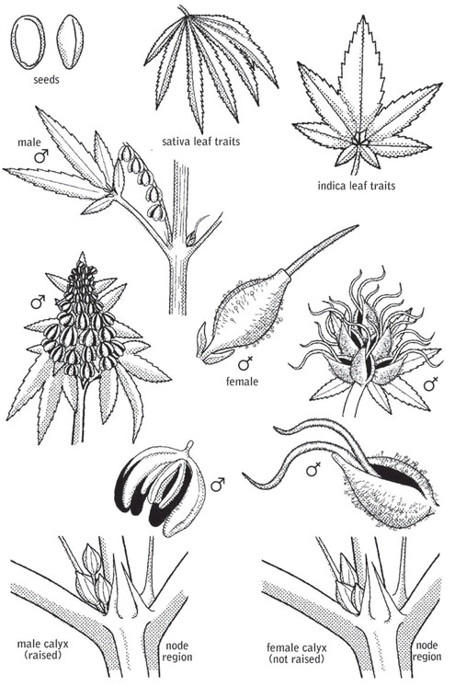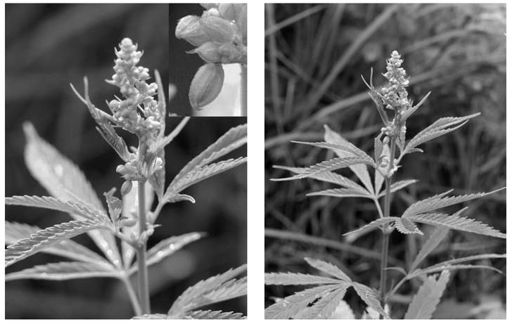The Cannabis Breeder's Bible (10 page)
Read The Cannabis Breeder's Bible Online
Authors: Greg Green

He then uses gibberellic acid, mixing 30 centiliters of water with 0.02 grams of gibberellic acid and 2 drops of natruim hydroxide to liquefy the gibberellic. Then applies as normal and creates the male flowers. He has gotten down to the 4th generation without loss of vigor, and with no genetic deficiencies and hermaphrodites. He claims that the plants are exact genetic clones of one another, complete sisters. Basically it’s cloned from seed instead of from normal cloning methods.
Posted by The Silicon Magician on February 13, 1999 at 05 : 17 : 41 PST
Mr. XX also says that it’s easy for the home grower to find an XX female. It’s a very time-consuming process but a straightforward one. He advises home growers to confine themselves to a single strain. Mr. XX used a Skunk#1 x Haze x Hawaiian Indica. He says to separate those plants from your main grow and stress them severely. Do this repeatedly with every new crop of seeds you get of that strain until you find the XX female. While this is time consuming it is by no means impossible.
CONCLUDING THOUGHTS ON BREEDING
Experimentation results in new hybrids. Stabilized hybrids result in new strains. It is far better to generate one excellent stable strain than to generate several unstable average ones. Breeding is a long-term commitment. Many breeders stop breeding after only a few years because of lack of time, space and money. Although they may have learned something about breeding in that short a time, they will not have had the opportunity to put it into practice. If you want to breed cannabis then be prepared to spend a few grows getting the basics right first.
Breeding is all about recognizing which traits are worth continuing. Do not be afraid to admit that you do not have anything worth breeding. Some of the best breeders have gone through dozens of different populations before finding a plant that stands out from the rest.
There are many reasons to breed your own strain of cannabis. Try to find an original idea for breeding your own cannabis strain. Original ideas always seem to work out best.
3
DONOR PARENTS, POLLINATION AND SEEDS
USING PARENT PLANTS TO CREATE MORE THAN ONE STRAIN
The previous chapters have helped us develop a notion of what breeding is all about and what principles are involved in breeding strains for traits that we want to see produced in a population of cannabis plants. A breeder only needs two parent plants to create the final produce.
However you may find that a breeder uses a mother plant to produce several different products (strains/hybrids). Let’s imagine that a breeder sells the following items: Masterkush, Blueberry and Kushberry.
You can probably guess that the breeder is using a similar template for each strain, although some breeders are clever and may give their strains different names to make it seem like these strains are all developed from different parents.
Let’s say for a moment that each strain is known to be related to similar parent plants and it is our goal to figure out what those parents are.
Masterkush is probably a true breeding strain for a large percentage of its traits. The same applies to Blueberry. By doing a little research and asking around we may find that the breeder released these strains first. These two strains are very different in their phenotypes so we can guess that the breeder has two parents for each strain. These are:
Masterkush = Masterkush female parent #1 x Masterkush male parent #1. Through breeding both parents the breeder produces Masterkush seeds.
Blueberry = Blueberry female parent #1 x Blueberry male parent #1. Through breeding both the parents the breeder produces Blueberry seeds.
So for these two strains the breeder has four parent plants on the table as his main breeding stock.
When we grow out a large population of Kushberry we may notice that the strain has some variations. If so, then we know that the Kushberry’s parents do NOT breed true for certain traits. This means that the Kushberry’s parents are probably:
Masterkush female parent #1 x Blueberry male parent #1
or
Masterkush female parent #1 x Blueberry male #1.
In this case we can guess that the breeder has only the four parent plants for their Masterkush, Blueberry and Kushberry strains. Only two of these strains are considered stable by definition—the Masterkush and the Blueberry.
The Kushberry is an F1 hybrid!
If we grow out a large population of Kushberry and notice that there are no variations in any of the traits then we know that the breeder has actually developed parents for the Kushberry that will breed true for the Kushberry traits. This means that the breeder has not four parent plants, but six.
If you are asking the question if there is a difference between using the male or female version of each parent for the resulting hybrid the answer is in what you have already learned in the previous chapter. Let us look at the Punnet tables for each.
Masterkush has BB for brown bud color. Blueberry has bb for blue bud color. Since both strains are stable there is no Bb in their individual populations.
Masterkush male #1 x Blueberry female #1
| b | b | |
|---|---|---|
| B | Bb | Bb |
| B | Bb | Bb |
Blueberry male #1 x Masterkush female #1
| B | B | |
|---|---|---|
| B | Bb | Bb |
| b | Bb | Bb |
It seems like both ways will produce Bb, brown bud color, so there it makes no difference which male or female we use. However let us continue on with another trait. Masterkush has cc for a small calyx. Blueberry has CC for big calyx. Since both strains are stable there is no Cc in their individual populations.
Masterkush male #1 x Blueberry female #1
| c | c | |
|---|---|---|
| C | Cc | Cc |
| C | Cc | Cc |
Blueberry male #1 x Masterkush female #1
| C | ||
|---|---|---|
| c | Cc | Cc |
| c | Cc | Cc |
It seems like both ways will produce Cc, big calyx, so it makes no difference which male or female we use. This means that in stable strains, without variations in the populations, the male or female selection does not change the resulting offspring.The resulting offspring will only change with the different male and female selection if we breed the resulting offspring or if we are use heterozygous traits to begin with.
| C | c | |
|---|---|---|
| C | CC | Cc |
| C | CC | Cc |
| C | c | |
|---|---|---|
| c | Cc | cc |
| c | Cc | cc |
This will help you understand more about the actual propagation of genetics. You may be wondering at this point:
Is it possible for the breeder to create a true breeding hybrid if by some fluke of nature the two parent plants combine in such a way that no heterozygous genotypes are produced?
We already know from chapter 2 that the very term
true breeding hybrid
is untrue. It simply does not exist, so this statement is not possible.
THE STRAIN’S PARENTS
Ideally a strain should have two parents that are unique only to that strain. Nowadays it is very common to see well-liked strains produce new hybrids that have some association with the well-liked strain’s parents. A good example of this would be to take two very popular strains like Northern Lights and Haze. Recently NL x Haze has come onto the market and has gained some popularity. It is highly unlikely however that NL x Haze is as stable as NL or Haze. There will probably be variations in the population until such time as the breeder develops NL x Haze parents that are unique to that line and breed true.
This is very important to know about, especially in situations where a breeder has developed two very popular strains only to produce a third cross between the two. This third cross is usually less stable than the line from which it came, although over time the breeder will undoubtedly develop separate parents to make this line more uniform in growth. One very popular strain that is being developed for more stability at the moment is Jack Flash from Sensi Seeds. Jack Flash is a very popular variation of the famous Jack Herer strain that revolutionized the industry. Every year Jack Flash becomes more stable. This suggests that the breeder is making headway in developing two unique parents that will eventually combine to create a Jack Flash that is very uniform in its traits.
The Male Parent
Because the female parent is generally the parent that we are trying to improve on, or recreate, we have a problem with selecting the right male for the job. Male plants do not exhibit female floral traits and so the initial selection of the contributing male is blind.
In order to assess the male plant’s breeding qualities you must perform test crosses and consider the results in the offspring
4
. This is very dependant on the female and how the male’s genes combine with those of the female to produce various traits. Testing males is just as important as testing females. By making the right male selection you can enhance your strain in almost every single trait.
The more males that you work with, the better your chances are of finding a male donor parent that gives very unique properties to the offspring. Some males are so helpful in increasing yields and potency that they become as important as a good clone mother.

This male is only a day or two away from producing pollen. Photographs by Kissie.

Pollinating
Males can drop pollen anywhere between 12 hours and 3 weeks from initial calyx development. For this reason breeders and growers want to get to the males as soon as possible. The problem with male identification is that initial calyx development is subtle and although there are signs that a given plant could be a male in the initial stages of calyx development, the definitive factor is in the actual flowering phase.
Males tend to grow taller than females but this is tentative. Males also tend to show their sex before females but again this is not definitive. Males also have a raised calyx on a short stem but sometimes the odd female can show this too. Growers and breeders should endeavor to tag males in the early days of calyx development or even remove them from the grow area until such time as the flowers actually show. Never put all your eggs in one basket until you know for sure (
CGB,
pp. 100-103).
Male calyx development also usually occurs in clusters very quickly—so if you see more than one calyx developing at the node you can be almost sure that the plant is male.
As noted above, most males can be very quick to shed pollen. In the initial stages of calyx development a male will often start to produce pollen right away. I personally have witnessed males shedding pollen within a day after initial calyx development, although it typically takes a few more days than just one. The moral here is to keep an eye out for calyx development as you near the end of vegetative growth.
